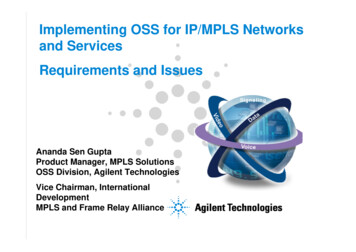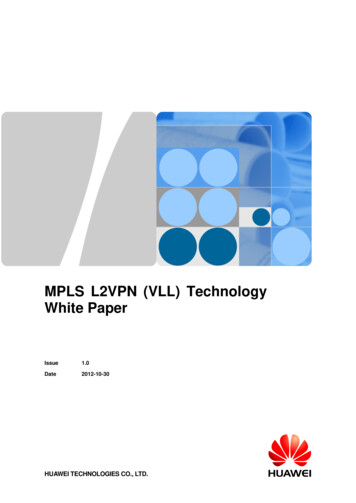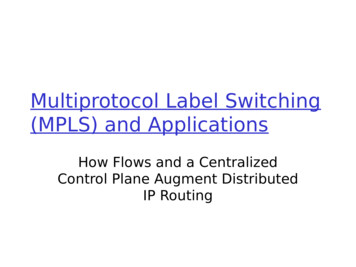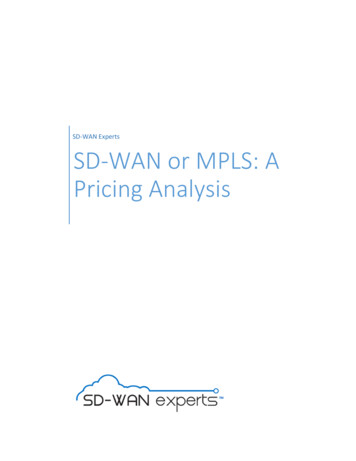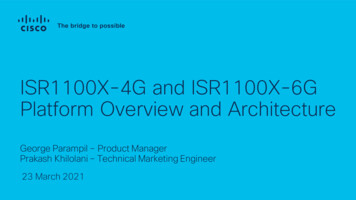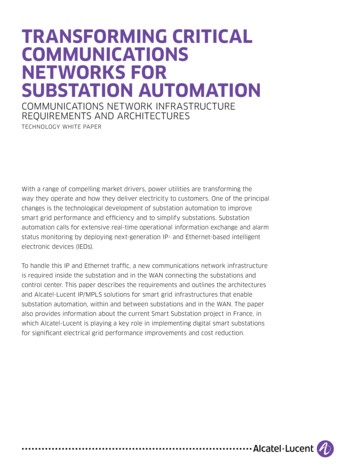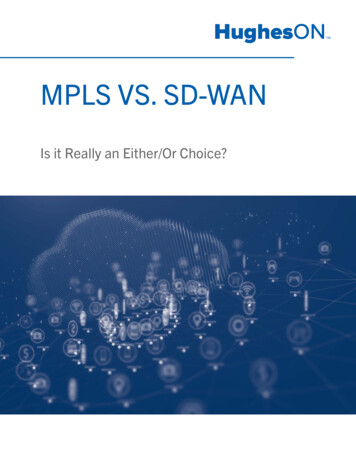
Transcription
MPLS VS. SD-WANIs it Really an Either/Or Choice?
INTRODUCTIONFor 25 years, MPLS reigned as the preferred networking service. Withthe advent of SD-WAN, enterprises and agencies should comparerelative advantages and disadvantages as they evolve their networks tomeet changing needs.Multiprotocol Label Switching (MPLS) has been widely deployed acrosscommercial and government networks over the past 25 years. However, the timehas come for many organizations to consider evolving their networks from MPLSto Software-Defined Wide Area Networks (SD-WAN) for cost-savings, agility,and scalability, especially when considering Cloud deployments and increasingdemand for heightened network security.Here, we compare MPLS vs SD-WAN and explore their relative advantages anddisadvantages.MPLS VS. SD-WAN2
The Battle of BandwidthAs a routing technique, MPLS applies a circuit-switched discipline to deliver packets andavoid packet loss over a distributed network. That means it is reliable and efficient at keepingtraffic flowing. In addition, since the buyer leases the entire circuit, it is not shared withanyone else, making it inherently more secure. Most organizations with an MPLS networkconnect their locations and branch offices to a central data center, using a hub-and-spokeWAN model to connect the different points. Data travels to the data center to be processedand redistributed to the branch.That approach worked well for decades. But that was before the Cloud, bandwidth hungryapps, broadband, Software as a Service (SaaS) and our culture’s wholesale reliance on theInternet—all of which have diminished some of the distinct advantages of MPLS.Insufficient BandwidthBecause MPLS was designed for networks that depended on data centers, it simply is notwell-suited for situations where branch or field office employees want or need direct accessto the Cloud. Organizations with MPLS networks that have adopted Cloud applications must“backhaul” all traffic from their branches through their data center (or HQ) and on to theCloud. Backhauling causes slower Internet access due to the delay or latency associatedwith routing traffic over longer distances to the data center and then on to the Cloud service,leading to poor user experiences. When critical Cloud applications are involved, productivityalso suffers.MPLS VS. SD-WAN3
The problem has been magnified in the last few years bythe steady rise in video traffic. In 2018, Cisco predictedthat video would account for 82% of all internet trafficby 2022.1 That was before the pandemic and the 70%spike in Internet use in 2020; and before Zoom hadover 300 million meeting participants per day on itsvideoconferencing platform.2Typical MPLS networks depend on T1 lines that arelimited to only 1.5 Mbps service; the challenge here is thatthe standard T1 line is too small for bandwidth hungryapps and the growing number of users and devices.Since there’s no end in sight to these usage trends,organizations will likely find themselves playing a costlygame of catch up as they strive to meet rising bandwidthdemands by adding new T1 lines, which may proveinsufficient and not resolve performance issues.Inescapable CostsIn addition to MPLS networks being inefficient when itcomes to operating in a Cloud environment, they arealso expensive compared with IP-based broadbanddeployments. Today, it’s easier and much less expensiveto add IP-based broadband than new private MPLSconnections. Because MPLS is purchased as an entireleased line from a carrier, it is far more expensive thansending traffic over the public Internet — especially inmore remote areas where costs are dictated by circuitdistance. Even with new services like 3, 5, and 10 MbpsEthernet, the costs are still much higher than IP-basedbroadband.If a network needs to be expanded geographically, there isalso the added expense of infrastructure and the commondelays associated with deployment. As organizationsexpand into new areas, they may find it difficult to identifyan MPLS service provider capable of coverage. For allthese reasons, it is not unusual for broadband to delivercost savings of 60% to 70% when compared to T1 andother MPLS transport options.1 nt-for-82-all-internet-traffic-by2022-cisco-says2 MPLS VS. SD-WAN4
SD-WAN as a Leading AlternativeWith the advent of SD-WAN, there’s another option to meet the changing needs of distributednetworks. SD-WAN is a virtualized WAN architecture that connects and extends networksover large geographical distances. SD-WAN can simplify branch or field office networking andassure optimal performance and security protocol application, creating a network with morecapacity and security than MPLS. In their 2020 WAN Market Survey Report, Gartner statedthat SD-WAN is now “becoming the de facto option for new WAN edge sourcing initiatives.”So, what are the differences between the two? As noted, traditional MPLS networks relyon static physical links to connect remote or branch users to applications hosted in datacenters via a hub-and-spoke design. Data flow is typically determined by a network engineeror administrator who writes rules and policies, often manually, for each router on thenetwork—a process that can be time-consuming and prone to errors.SD-WAN, on the other hand, uses software to control and manage network traffic from acentral location with dynamic execution at every site. SD-WAN routes application traffic overthe best path in real time. In the case of Cloud services like SaaS, SD-WAN can connect toInternet- and Cloud-bound traffic directly from a branch, doing away with backhauling anddelivering improved user experiences.SD-WAN can also manage multiple types of connections, including MPLS, broadband, LTEand others, as well as support applications hosted in data centers, public and private Clouds,and SaaS services like Salesforce.com, Workday, Office 365, and Dropbox.The flexibility and scalability of SD-WAN enable an organization to either shift completelyaway from MPLS or to apply a hybrid approach, seeking the right mix of MPLS connections(for high-priority data center applications, for example), broadband (for high-bandwidth andInternet-based applications), and even 4G LTE (and eventually 5G) wireless connectionsto meet each location’s needs. SD-WAN’s greatest strength might be its ability to leveragemultiple broadband transports to connect field office locations securely, reliably, and costeffectively to ensure users across the network have a consistent and high-performanceexperience. The result? Organizations with SD-WAN win the battle of bandwidth.MPLS VS. SD-WAN5
MPLS amid a Changing Enterprise EnvironmentBeyond bandwidth, another issue in the MPLS vs. SD-WAN discussion centers on theassumption that encryption or additional security measures aren’t necessary with MPLS. Yet,today’s enterprise environment differs dramatically from that of 25 years ago, when MPLSdebuted. In the late 1990s, remote workers, Cloud-based applications, and SaaS didn’t exist(or at least not in their current form!) Operations and technologies have moved far beyond whatMPLS was designed to support, and workarounds to its limitations often inject performanceinefficiencies and other security challenges. Not only have technologies evolved, securitypractices and protocols have, too.Because MPLS depends on predetermined routes that need to be designed and provisionedby knowledgeable network engineers, making changes to the network calls for significantexpertise and effort. As a result, any small update to the MPLS network and its securityrequires coordination between telecom operators and IT teams. If that doesn’t happen, securityvulnerabilities can be exposed, and overall risk levels rise.Unfortunately, applying Cloud security to MPLS doesn’t solve the issue. One of the advantagesof MPLS is its efficient point-to-point architecture. By forcing an MPLS network to route to aCloud security provider, traffic flows outside the network, adding extra destinations (hops) andlatency into the path; all negating point-to-point efficiencies.Similarly, Zero Trust Network Access (ZTNA) or two-factor authentication must be validatedelsewhere, like at a data center or Cloud Access Security Broker (CASB), again nullifying theadvantages of an MPLS network. Here again, this routing of traffic outside the point-to-pointMPLS network requires extra steps (or hops) and increases network complexity and latency—inmany cases, to a greater degree than in an IP-based network optimized for this type of multi-hopapproach. Consequently, MPLS networks underperform compared to IP-based networks whenconnecting remote users and Cloud services. They also run counter to efforts by Hughes andother industry leaders to simplify networks and make them more flexible and agile.MPLS VS. SD-WAN6
MPLS VS. SD-WANA Hybrid Approach to the MPLS-to-SD-WAN TransitionGiven the challenges of securely connecting remote users and Cloud services via MPLS andits higher costs, does it make strategic sense for an enterprise to transition away from itsMPLS network? Eventually, yes. For the short term, however, many organizations will choosea hybrid approach with a combination of MPLS and broadband.As mentioned earlier, SD-WAN is transport agnostic and can be deployed to manage multipletypes of connections, including MPLS, broadband, LTE and others. Further, SD-WAN isdesigned to allow centralized management, allowing network policies to be easily appliedacross all WAN devices, creating network agility and simplifying operations. Even withapplications hosted in data centers, public and private Clouds, or SaaS services likeSalesforce.com and Office 365, SD-WAN routes application traffic over the best path in realtime to improve user experiences.Succeeding with a hybrid strategy hinges on understanding how and where to leverage theMPLS network’s advantages versus the Cloud-enabled SD-WAN solution’s benefits. Forexample, an organization may choose MPLS to connect multiple data centers or to supportapplications and traffic volume served exclusively from one data center, while usingSD-WAN to serve branch location traffic going to the Internet or Cloud services moreefficiently. This is ideal for sectors, such as healthcare and banking, which will likelyalways have justification for private circuits. Of course, organizations that don’t require theadvantages of MPLS can move confidently to a lower cost, more agile, and more capableSD-WAN network.Eventually, MPLS usage will shrink as SD-WAN capabilities fill the gaps. In fact, we alreadysee this across many Hughes customers. But there’s no pressing need to choose SD-WANover MPLS or to view it as an either/or proposition. MPLS will be with us for many more years.The key action is to assess your network needs, determine whether a hybrid approach fits,and develop a strategy for which sites and technologies should be supported by MPLS andwhich are better suited to SD-WAN. Then, as technology evolves and MPLS becomes lesscritical, your enterprise will be firmly positioned on the path to digital transformation.For a different look at how SD-WAN works, watch this video from our colleagues at HughesEurope.For additional information, please call 1-888-440-7126or visit hughes.com.hughes.com11717 Exploration LaneGermantown, MD 20876 USA 2022 Hughes Network Systems, LLC. HUGHES is a registered trademark and HughesON is a trademark ofHughes Network Systems, LLC. All information is subject to change. All rights reserved. H68048 JAN 22
SD-WAN is a virtualized WAN architecture that connects and extends networks over large geographical distances. SD-WAN can simplify branch or field office networking and assure optimal performance and security protocol application, creating a network with more capacity and security than MPLS. In their 2020 WAN Market Survey Report, Gartner stated
